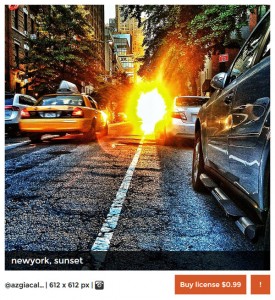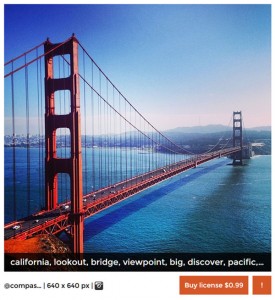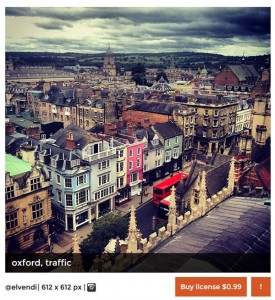“We want to become the largest market for social media content,” says Olga Egorsheva, co-founder and CEO of Lobster IT Limited. Her London-based tech company is run by a close-knit group of computer science students who met at Moscow State University. The team includes a photographer, a designer and an art buyer, each clearly mindful of the create-buy-use image transaction model.
Like other startups in this space, they feel strongly about trying to prevent social content stealing. As for the name, Egorsheva claims Lobster is fun and memorable, plus, “…lobsters grab everything in the ocean as we grab content anywhere on the Internet through social media.”

Using APIs, Lobster sources user generated content from social platforms, specifically Instagram and Flickr right now. That means maintaining working relationships with Facebook and Yahoo, even if only through the API functionality for starters. As for the popular sharing communities themselves, the prospect of a 75 percent revenue stake is encouraging sellers to sign up.
On the contributor side, sellers create a profile on Lobster and use the hashtag #ilobsterit in the caption or comment fields of images they want to add to Lobster’s marketplace. The hashtag becomes the basis for signaling buyers that their images are for sale. Selling with Lobster is on a non-exclusive basis once the content creator accepts their terms.
Bargain-basement prices are preset for all content, though Lobster envisions increasing licensing fees down the road as well as allowing sellers to set their own prices. Instagram files are $0.99; Flickr files are $1.99; video files are $2.99. Future pricing models will also be rating-based. For example, the more Instagram images you sell, the higher your Lobster rating, which then triggers a higher licensing fee.
With 75 percent of the sale going to the contributor, that’s $0.74 for a 640 x 640 pixel Instagram shot, a file size suitable for Web use. Interestingly, the downloadable file for Flickr images is sized at 7360 x 4912 pixels, dimensions large enough for nearly all print applications.

The broadly-worded usage agreement granted by the seller is for a full, worldwide non-exclusive commercial or editorial royalty-free license. Sellers are encouraged to tag their content with further hashtags:
- #editorialuse: Content can be used for Editorial use. Any required Model Release and/or Property Release has not been obtained;
- #modelrelease: All necessary Model Releases have been obtained by the Seller and may be provided to Buyers upon request;
- #propertyrelease: All necessary Property Releases have been obtained by the Seller and may be provided to Buyers upon request.
For buyers, searching the collection presents the biggest hurdle. Lobster’s search parameters are limited to the image’s description, hashtags and built-in date and geographic metadata. Keywording is all user-determined and that can mean messy results. Lobster is working to educate their contributors on better captioning practices and they also plan to integrate image recognition software that automatically adds color, emotion and other symbolic keywords to files.

To improve the buyer’s research experience, Egorsheva says there will be both in-house and crowd sourced curation and rating of images. Currently, the homepage sorts photo streams by three categories: trending topics, bestsellers and nearby. Lobster runs photo challenges so sellers have topics to shoot and a chance to win site promotion and other prizes. The images curated for the nearby category result from Lobster capturing the seller’s image coordinates and then matching those with the viewer’s IP address location.
Transactions go through PayPal so buyers and sellers will need to establish an account there. Should buyers want to reach sellers for more information or alternate file sizes, Lobster plans to launch a direct messaging capability. This communication tool within Lobster will allow buyers to directly submit a buy request, even for non-hashtagged photos.
Once an image has been purchased, Lobster stores a copy on their servers so the buyer always has access to the file, even if the seller has deleted the photo from their own social media account. If a seller changes their mind about offering an image for sale via Lobster, they can remove #ilobsterit from the file but there is a delay, even up to 24 hours, before the photo will be removed from Lobster’s marketplace.

Growth is steady. Lobster reports about 100,000 images and videos to date from about 1500 users. The first paying customers are starting to arrive as their marketing efforts ramp up. They’ll be pursuing other social media sites including Vine, Twitter and Behance and audio sharing sites such as Soundcloud. In the meantime, Lobster will be attempting to crawl through as much territory as possible in an ocean of online content.

